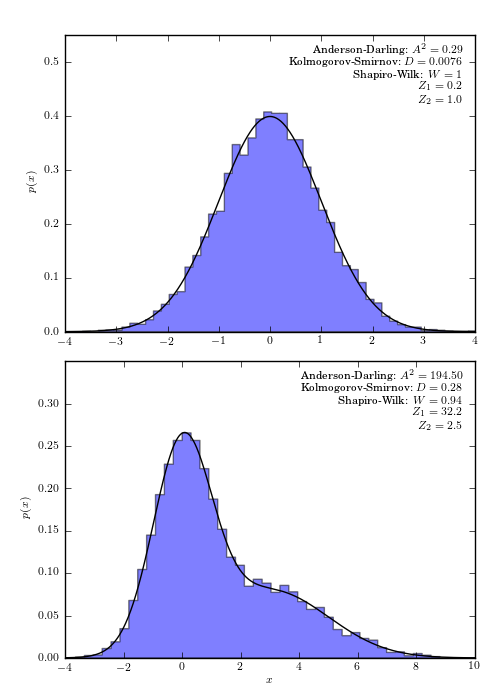Gaussianity Tests¶
Figure 4.7.
The results of the Anderson-Darling test, the Kolmogorov-Smirnov test, and the Shapiro-Wilk test when applied to a sample of 10,000 values drawn from a normal distribution (upper panel) and from a combination of two Gaussian distributions (lower panel).
The functions are available in the scipy package:
- The Anderson-Darling test (scipy.stats.anderson)
- The Kolmogorov-Smirnov test (scipy.stats.kstest)
- The Shapiro-Wilk test (scipy.stats.shapiro)

WARNING: p-value may not be accurate for N > 5000. [scipy.stats.morestats]
______________________________________________________________________
Kolmogorov-Smirnov test: D = 0.0076 p = 0.6
Anderson-Darling test: A^2 = 0.29
significance | critical value
--------------|----------------
0.58 | 15.0%
0.66 | 10.0%
0.79 | 5.0%
0.92 | 2.5%
1.09 | 1.0%
Shapiro-Wilk test: W = 1 p = 0.59
Z_1 = 0.2
Z_2 = 1.0
WARNING: p-value may not be accurate for N > 5000. [scipy.stats.morestats]
______________________________________________________________________
Kolmogorov-Smirnov test: D = 0.28 p = 0
Anderson-Darling test: A^2 = 1.9e+02
significance | critical value
--------------|----------------
0.58 | 15.0%
0.66 | 10.0%
0.79 | 5.0%
0.92 | 2.5%
1.09 | 1.0%
Shapiro-Wilk test: W = 0.94 p = 0
Z_1 = 32.2
Z_2 = 2.5
# Author: Jake VanderPlas
# License: BSD
# The figure produced by this code is published in the textbook
# "Statistics, Data Mining, and Machine Learning in Astronomy" (2013)
# For more information, see http://astroML.github.com
# To report a bug or issue, use the following forum:
# https://groups.google.com/forum/#!forum/astroml-general
import numpy as np
from scipy import stats
from matplotlib import pyplot as plt
#----------------------------------------------------------------------
# This function adjusts matplotlib settings for a uniform feel in the textbook.
# Note that with usetex=True, fonts are rendered with LaTeX. This may
# result in an error if LaTeX is not installed on your system. In that case,
# you can set usetex to False.
from astroML.plotting import setup_text_plots
setup_text_plots(fontsize=8, usetex=True)
from astroML.stats import mean_sigma, median_sigmaG
# create some distributions
np.random.seed(1)
normal_vals = stats.norm(loc=0, scale=1).rvs(10000)
dual_vals = stats.norm(0, 1).rvs(10000)
dual_vals[:4000] = stats.norm(loc=3, scale=2).rvs(4000)
x = np.linspace(-4, 10, 1000)
normal_pdf = stats.norm(0, 1).pdf(x)
dual_pdf = 0.6 * stats.norm(0, 1).pdf(x) + 0.4 * stats.norm(3, 2).pdf(x)
vals = [normal_vals, dual_vals]
pdf = [normal_pdf, dual_pdf]
xlims = [(-4, 4), (-4, 10)]
#------------------------------------------------------------
# Compute the statistics and plot the results
fig = plt.figure(figsize=(5, 7))
fig.subplots_adjust(left=0.13, right=0.95,
bottom=0.06, top=0.95,
hspace=0.1)
for i in range(2):
ax = fig.add_subplot(2, 1, 1 + i) # 2 x 1 subplot
# compute some statistics
A2, sig, crit = stats.anderson(vals[i])
D, pD = stats.kstest(vals[i], "norm")
W, pW = stats.shapiro(vals[i])
mu, sigma = mean_sigma(vals[i], ddof=1)
median, sigmaG = median_sigmaG(vals[i])
N = len(vals[i])
Z1 = 1.3 * abs(mu - median) / sigma * np.sqrt(N)
Z2 = 1.1 * abs(sigma / sigmaG - 1) * np.sqrt(N)
print 70 * '_'
print " Kolmogorov-Smirnov test: D = %.2g p = %.2g" % (D, pD)
print " Anderson-Darling test: A^2 = %.2g" % A2
print " significance | critical value "
print " --------------|----------------"
for j in range(len(sig)):
print " %.2f | %.1f%%" % (sig[j], crit[j])
print " Shapiro-Wilk test: W = %.2g p = %.2g" % (W, pW)
print " Z_1 = %.1f" % Z1
print " Z_2 = %.1f" % Z2
# plot a histogram
ax.hist(vals[i], bins=50, normed=True, histtype='stepfilled', alpha=0.5)
ax.plot(x, pdf[i], '-k')
ax.set_xlim(xlims[i])
# print information on the plot
info = "Anderson-Darling: $A^2 = %.2f$\n" % A2
info += "Kolmogorov-Smirnov: $D = %.2g$\n" % D
info += "Shapiro-Wilk: $W = %.2g$\n" % W
info += "$Z_1 = %.1f$\n$Z_2 = %.1f$" % (Z1, Z2)
ax.text(0.97, 0.97, info,
ha='right', va='top', transform=ax.transAxes)
if i == 0:
ax.set_ylim(0, 0.55)
else:
ax.set_ylim(0, 0.35)
ax.set_xlabel('$x$')
ax.set_ylabel('$p(x)$')
plt.show()
